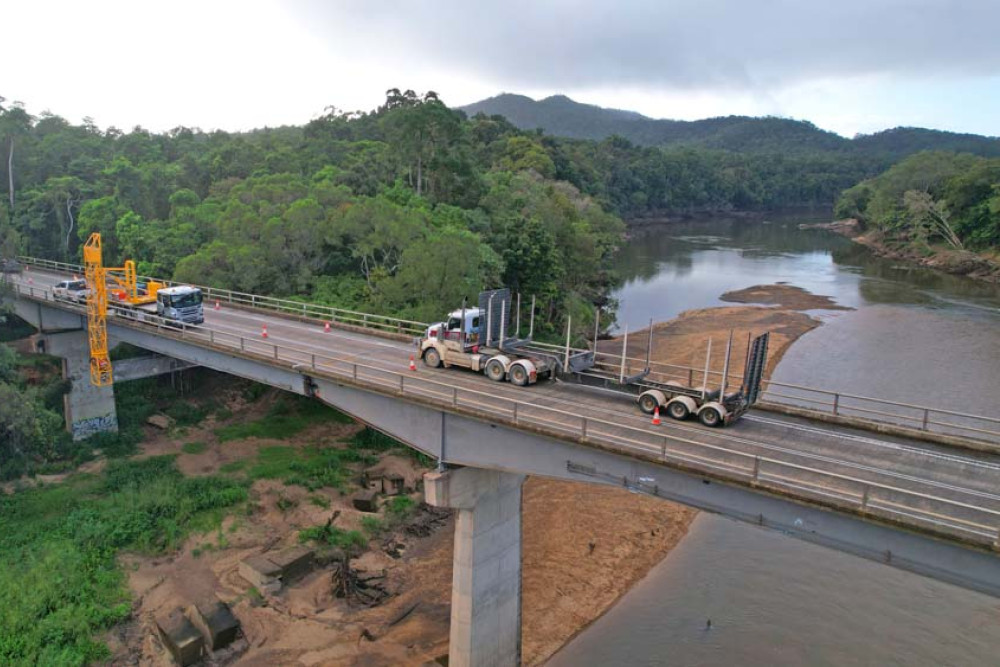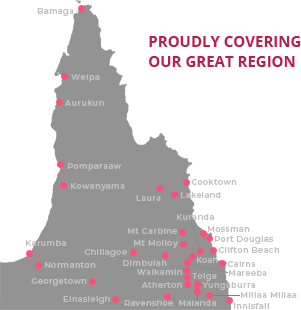Community & Business
4 June, 2024
bridge on the brink
Dramatic changes to the way trucks use the Barron River bridge at Kuranda are looming as authorities get more concerned about the weight the ageing structure can take.

Trucks could be banned altogether or have to operate under a permit system to reduce the weight on the 60-year-old bridge.
Commuters will likely also have to endure up to six years of driving across in a single lane as the State Government “scrambles” to build a new bridge that will cost hundreds of millions of dollars.
With the State Budget to be released next week, Member for Barron River Craig Crawford says his top three priorities are “the bridge, the bridge, and the bridge”.
“There is no click our fingers (and fix it) on this – the fix is a new bridge,” he said.
TRUCKS may only be able to cross the Barron River bridge at Kuranda with a permit in the future, while motorists will have to endure single-lane traffic for the next 5-6 years, as the State Government “scrambles” to build another bridge to replace the ageing structure.
Concerns have been heightened about the bridge’s condition after Main Roads revealed that an issue with a Macalloy tension bar, which had been retrofitted to provide additional strength, had forced them to reduce traffic to one lane for safety reasons.
While inspections are continuing and technical experts are assessing what the issue means for the future use of the bridge, Member for Barron River Craig Crawford has revealed it could mean significant changes for heavy transport and years of disruptions for commuters.
It is understood around 1000 heavy vehicles use the bridge every day.
“Essentially the simplistic way to describe the problem or the solution on the current bridge is really about the weight on any part of the bridge at one time,” he said.
“So, two heavy vehicles crossing at the same time that meet in the middle at that precise moment, their combined weight is pushing down.
“That’s why they (Main Roads) have single laned it because they are trying to reduce the weight at any one point at any one time but they are also bringing that traffic to the middle of the bridge which keeps the pressure and stress off the sides.
“I think we are likely to see more of these kind of decisions from the engineers going forward about keeping it open and trying to limit the weight.”
Mr Crawford said that in recent weeks, Main Roads “had started to shift their language about the urgency of it” now that the issue with the tension bars had been discovered and they had a “whole suite of options” to restrict weight onto the bridge.
“The problem’s going to be the heavy transport – you can run a whole bunch of cars over it and the weight’s not too bad but the moment you put a 20-30-40 tonne truck on there, it’s a problem,” he said.
“It’s going to be up to the engineers– it’s all about weight – it may be as simple as saying a truck can’t be over a certain amount of tonnage or, if they think it was safe enough to do so, they may say you can bring your truck over but it’s at this time, under this permit under these conditions – it may have to be escorted, who knows.
“TMR could use permits for the Gillies (Range), they could do a permit system for the Kuranda bridge, enabling heavy transport to use it under permit at certain times, but it’s going to be for the next 5-6 years.
“We never want to get to a point where you can’t take a car across, then we’re really up a creek. The idea is we need to keep that bridge open – I would far prefer to see delays than a road closed sign.”
He said the bridge should have lasted 100 years, but problems had been detected only around five years ago, particularly in relation to the steel deck that was used when it was constructed in 1963 instead of a concrete deck.
“Not only are we seeing concerns but it seems to be escalating – the more you look, the more things you find,” he said.
“It was the decision made way back then to use a steel deck that we’re now paying for.
“It would have been great if they’ve had noticed it 10 years ago because we would have had time up our sleeve, but I’m really concerned that we’re not going to have enough time and that we are going to see changes to heavy vehicle loads over the next five years as we quickly scramble to build a new bridge.”
Leading up to the State Budget next Tuesday, Mr Crawford told The Express he had made it clear to the Treasurer that his priority was to get immediate action on replacing the 60-year-old structure.
“From a budget perspective, it’s ‘Dear Treasurer, priority items 1, 2 and 3 from me is the bridge, the bridge, the bridge,” he said.
“The business case is currently underway. It’s not due to be completed for a few months yet, but I am pressuring them to say we need to be ready to move straight into detailed design if the business case says we have to replace it.”
That will take years during which time the way heavy vehicles use the bridge are likely to change dramatically.
“There is no click our fingers (and fix it) on this – the fix is a new bridge,” Mr Crawford said.
“It takes probably a year-and-a-half to do the detailed design, and then you award a contract and it’s probably a three-year build for something of that size and we’re talking about hundreds of millions of dollars.
“I don’t think the money is the issue – it has to happen – government will simply have to do it.”


